Siberia:a grave for over a million subjects of the Romanov-ruled empire. However, the murder for the inmates was not so much the penalty of exile as the journey to this deadly frosty abyss of Asian Russia
In 1591, the body of the future heir to the Moscow throne, Tsarevich Dmitri, was found in Uglich. Suspicions fell on the main competitor, Boris Godunov. The incited crowd at the sound of the church bell was supposed to do justice itself. Tumult was quickly suppressed, and Godunov, as part of the rematch, decided to punish the culprits. One hundred rebels were whipped, then their nostrils were torn open, and even more of the talkative ones their tongues were cut off.
In the end, the rebels were expelled to Siberia, conquered by the Russians just nine years earlier.
On the way to the place of execution, they were accompanied by a bell. It is him, as Daniel Beer writes in his latest book, " The House of the Dead. Siberian torture in the times of the tsars "," Silenced and exiled (...) became a symbol of the power of the rulers of Russia, able to drive rebellious subjects beyond the Urals and effectively shut their mouths off ". He became the emblem of all those sent to the vestibule of Hell.
Over the following centuries, Siberia became a place of exile of political opponents, religious dissenters, but also vagrants, prostitutes, murderers and common thieves. They were not only to serve their sentence, but also to work for the Romanov Empire. Use the potential of this wild land.
Giving any precise data on those sent to Siberia, especially in the early modern period, seems extremely difficult. It was only when Empress Elizabeth replaced the death penalty with forced labor in this area in 1732 that the list of exiles began to be drawn up regularly. With the expansion of the prison system in the nineteenth century and the need to get new hands for work, the number of convicts increased. It is estimated that in the years 1801-1917 this phenomenon reached its apogee and could affect over a million people .
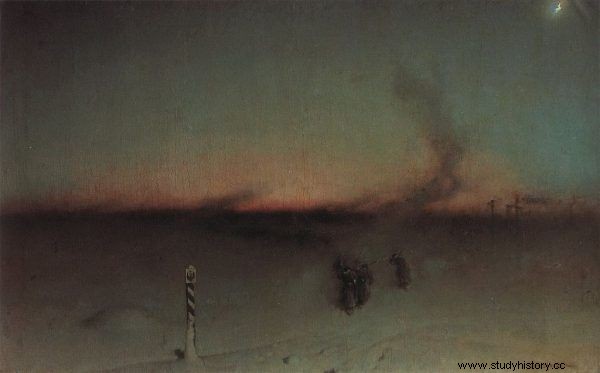
Siberia was a truly wild land. The Romanovs, however, decided to use its potential, creating an area almost completely inhabited by convicts. Witold Pruszkowski's painting "In exile to Siberia".
Deadly Convoy
It was in the nineteenth century that the mechanism of the organization of exile was formed, the image of which has survived in our consciousness to this day. The prisoners made their murderous journey to Siberian provinces thousands of kilometers away from the European part of Russia on foot. The columns set out from five cities:Petersburg, Białystok, Kamieniec Podolski, Chersoń and Tiflis. All of them met in Moscow and, after a briefing in the Main Transit Prison, set out on the infamous road of bones called Vladimirka towards the place where the sentence was served.
The journey to the icy prison could take from several months to several years. However, it did not count towards the length of the sentence announced. In the column, alongside people exiled to Siberia as political or religious dissidents, there were petty criminals and recidivists. From the very beginning, this caused many tensions between the prisoners themselves; there were thefts and even murders.
The situation of those sentenced to hard labor was the worst. They were considered the most dangerous. They always walked at the front of the column, with their hands handcuffed and their legs shackled. Often you could also see wooden logs used to pair prisoners . People sent to compulsory settlement followed them. Their situation was slightly better. They had "only" legs shackled. Then, in the column there were administrative prisoners - without shackles and chains. The last group were members of the families of convicts who went voluntarily to wander. The marching column was completed by four more carts on which the prisoners' belongings were traveling. The weight of the property was limited to twelve kilograms.
The size of the columns at the beginning of the 19th century was not limited by any legal regulations, which caused total chaos. The situation improved only after 1822, when it was established that the number of prisoners marching in one must not exceed sixty.
The columns that reached the Siberian provinces several thousand away were by no means similar to those that left the European part of the Romanov state. The prisoners came to the place of execution devastated by both the climate and the difficult living situation. In accordance with the regulations, they received a small salary from the state, consisting of:gray chinels made of rough material, coats and shoes; in winter, sheepskin coats, mostly made of very poor materials.
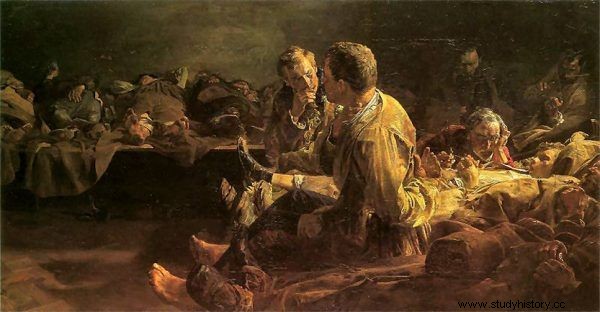
At first, all the convicts had to walk in chains. The daily walking numbers were 21 to 42 kilometers. After two days of travel, there was a day of rest. Jacek Malczewski's painting "Death on stage".
Already at the beginning of the journey, these things often fell apart, and the condemned man had to figure out how to survive. After crossing the Urals, there was always the possibility of trade with the native inhabitants of Siberia. These, however, were not always willing to exchange or the prices they dictated were so high that the prisoners could not afford new clothes. The lack of appropriate clothing and equipment on the way undoubtedly plagued the climatic changes that the wild Siberian lands deigned to the exiles. This is pointed out by Daniel Beer in his new book " House of the Dead. Siberian torture in the times of the tsars ":
During the summer heat, those walking at the end of the column were choking in great clouds of dust from hundreds of feet . In the open steppe, which stretched to the horizon, it was impossible to hide in the shade of trees, and the cloudless sky did not protect against the scorching sun. Many died on the march due to dehydration or sunburn. The autumn rains provided a temporary relief from the heat, but soon turned the roads into marshy swamps in which convicts sank down to the knees . The end of September heralded the first severe winter chills. At 20 degrees Celsius below zero, breath froze on the men's chins, turning them into chunks of ice; at -30 frost burned the lungs .
Violence, theft and hunger
Prisoners from the very beginning of their journey to exile were accompanied by omnipresent violence. They experienced it not only from their comrades, but also from the hands of the soldiers who supervised them. They could rob and brutally treat the convicts entrusted to their care. Personal searches in the cold and beatings were common. The situation of the women who were in the convoys with the men was particularly gloomy.
The inability to separate a small number of women from the large number of male prisoners contributed to rape and trafficking. Women who rebelled and put up active resistance were exposed to beatings and even loss of life. The soldiers who were escorting them also committed violence against women. They treated them as their property, which they could freely dispose of and sell to whomever they wanted. Numerous sexual contacts and the lack of proper hygienic conditions contributed to the spread of venereal diseases.
The widespread corruption among soldiers and officers supervising convicts was a common problem of the entire deportation system. It was to be curbed by the reforms carried out in 1822 by the governor of Siberia, Mikhail Spieranski. He divided the way of the convicts into individual stages, during which the prisoners had time to rest, and the team responsible for the escort changed. Unfortunately, numerous reorganisations of the column supervisors favored the practice of extortion and theft. Prisoners were often forced to sell to soldiers at reduced costs a part of their dilapidated clothes. And the convoy commanders who controlled the expenses strove to ensure that the small amount of money that the exiles had at their disposal was transferred to their families. These, in turn, had a monopoly on trade in food products at many staging points.
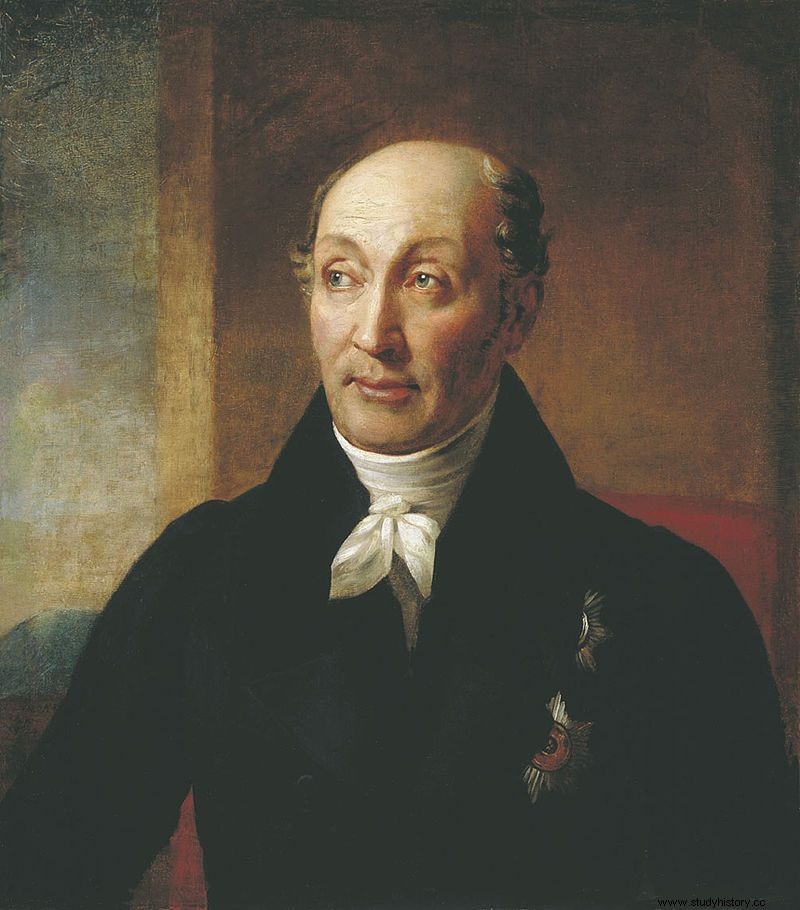
Mikhail Spieranski was a Russian politician who was appointed governor of Siberia in 1819. He then introduced a number of reforms to strengthen the local state administration, and in 1822 he improved the conditions of exile. Portrait by Aleksander Warnek.
Besides, the prisoners had to buy or steal food in order to survive. The state-guaranteed food rations were not only small, but were often stolen by soldiers. The prices were especially inflated. In addition, there were dishonest sellers who offered spoiled food products as a result of transactions. And that was a straightforward path to all kinds of diseases and epidemics.
A stop does not mean a rest
The real hotbed of disease, however, were the stopping places where prisoners were placed to rest. Initially, they were peasants' barns, cowsheds or meadows. With the reform of 1822, the prisoners' quarters were divided into three or four spacious chambers in stages. Each of them had a stove and rows of bunk beds. One cell could accommodate 30-40 people. The reality, however, was not so beautiful. Groups of up to 100 people were housed in these rooms.
The struggle for places on the beds began at the very beginning of the stop. The most powerful units were usually the winners; aggressive and seasoned criminals. The weak and the sick had to sleep on dirty floors. Considering the fact that the rooms were poorly heated, and the main companion of free time during the rest were clouds of insects and the stench that came from the excrement containers, it was easy to find an epidemic. Only during the typhus plague in 1868, which broke out in the Krasnoyarsk prison, the hospital with eighty beds had to accommodate 250 patients .
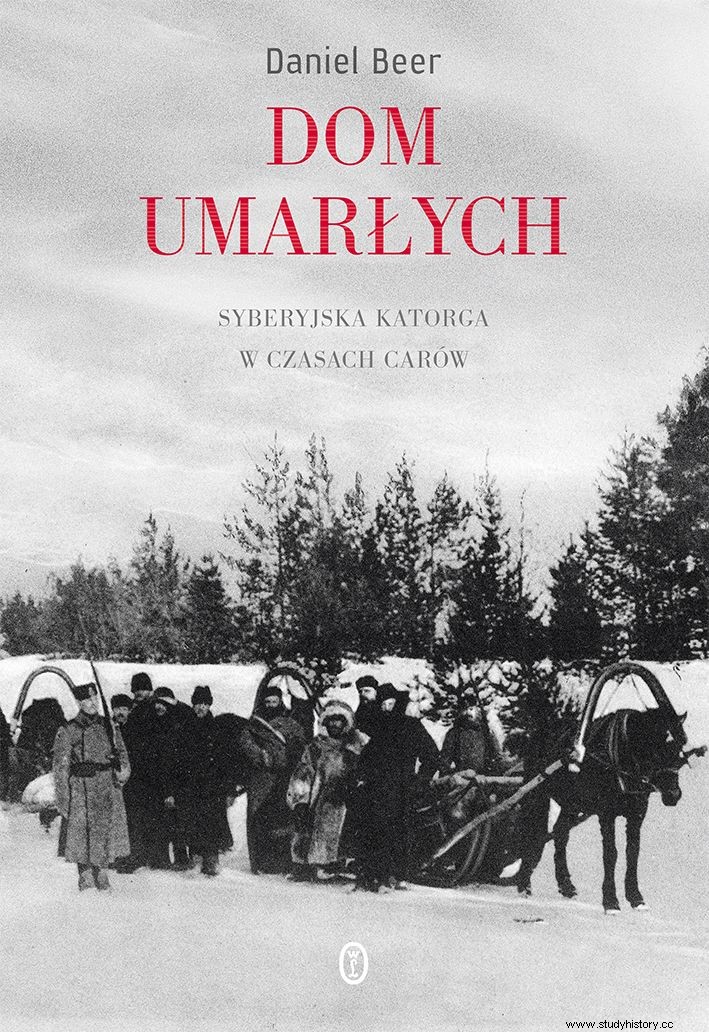
Artel
It was not, however, that the convicts did not have a chance to defend themselves against the brutality surrounding them. To this end, they formed associations called artels. Their task was to look after the prisoners during their journey. The members of the group chose a leader from among themselves. He was given money that was voluntarily donated by other prisoners. They were intended for bribes for soldiers or for the purchase of food.
Artel negotiated with the guards permission to beg in the villages on the route. Agreements were even made to allow the chains to be removed in exchange for a promise not to escape. In this case, this association vouched for all its members. In case of breaking the agreement, the whole artel was chasing down with escorting soldiers. Often punishing the fugitive before he got into the hands of the guards.
Despite this form of defense against the violence experienced by those exiled to Siberia, their journey was one great murderous march. Daniel Beer in his latest book " House of the Dead. Siberian hard labor during the times of the tsars ”Summarizes it this way:
The longer it took to travel east, the less they looked like an orderly column of prisoners, and more like a bunch of exhausted exiles (...). Low temperatures, preventing the march, blizzards and deep snowdrifts often turned the traveling convoys into death tests of endurance.
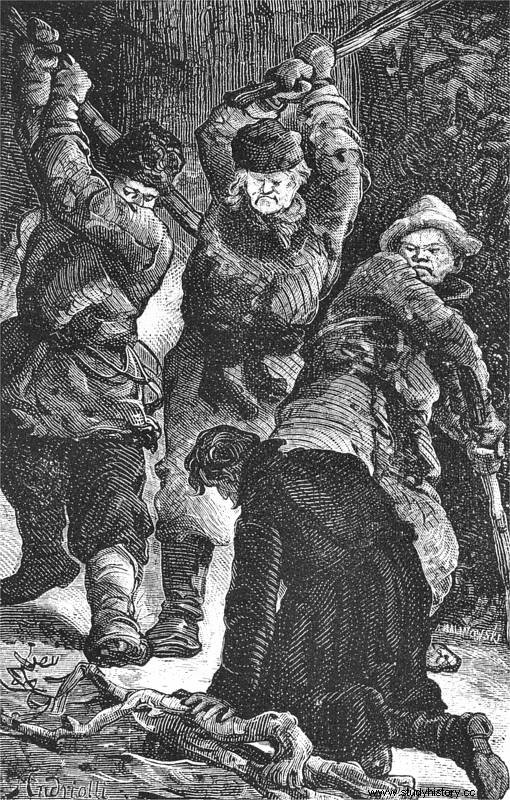
Sometimes even the artel was not able to protect the prisoners from the brutality of the soldiers supervising them, and even their co-indicated ones. The illustration shows one of the "Pictures of Siberia" by Michał Elwiro Andriolli.
(...) the inmates were plagued by numerous ailments: fever, attacks of rheumatism and colds, pneumonia and consumption, ulcers and chafing, rash from dirt and typhus, resulting from overnight stays in overcrowded buildings . According to some calculations, a third of all those who marched to Eastern Siberia, five thousand kilometers away, required treatment and convalescence at roadside field hospitals and medical care points. "People came here exhausted, prematurely infirm, suffering from incurable diseases," wrote a journalist. - People who have lost their professional skills and have become unaccustomed to work.
